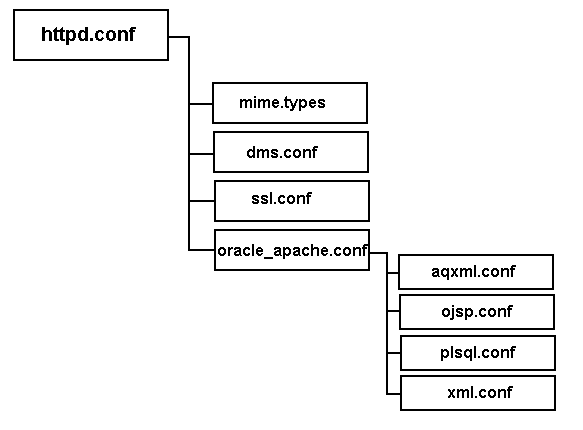| Oracle® HTTP Server Administrator's Guide 10g Release 1 (10.1) Part Number B12255-01 |
|
|
View PDF |
| Oracle® HTTP Server Administrator's Guide 10g Release 1 (10.1) Part Number B12255-01 |
|
|
View PDF |
This appendix lists commonly used Oracle HTTP Server configuration files.
Files discussed are:
Documentation from the Apache Software Foundation is referenced when applicable.
This is a server configuration file which typically contains directives that affect how the server runs, such as user and group IDs it should use, and location of other files. Because the server configuration file is the main file that the server starts with, Oracle HTTP Server does not include any directive that says where to locate it. The location is passed on command line when the server starts.
It is located at:
You should use only this file, and not srm.conf or access.conf because it is must easier to manage a single configuration file.
httpd.conf is arranged in the following sections:
This is section one of the httpd.conf file. It contains configuration directives dealing with Oracle HTTP Server.
This is section two of the httpd.conf file. It contains the directives of the default server.
This is section three of the httpd.conf file.It contains parameters specific to virtual hosts, which override some of the main server configuration defaults.
Figure A-1 illustrates the file structure of the httpd.conf file.

Text description of the illustration conffiles.gif
As shown in Figure A-1, httpd.conf contains directives to include configuration files such as:
mime.types controls the Multi Internet media types that are sent to the client for the given file extensions. Sending the correct media type to the client is important so that the client knows how to handle the content of the file. You can add extra types in the mime type file or add an AddType directive in the configuration file.
It is located at:
dms.conf enables you to monitor performance of site components with Oracle's Dynamic Monitoring Service (DMS).
It is located at:
oracle_apache.conf is included in the main configuration file to store configuration files of supported modules. It contains directives to include the following configuration files:
aqxml.conf enables and configures Advanced Queuing.
It is located at:
ojsp.conf configures Java Server Pages.
It is located at:
plsql.conf configures and loads the PL/SQL module.
It is located at:
xml.conf is associated the .xsql extension with the XSQL servlet.
It is located at:
ORACLE_HOME/xdk/adminORACLE_HOME\xdk\admin
# Advanced Queuing - AQ XML include "/private1/oracle/Apache/Apache/conf/aqxml.conf" # #Directives needed for OraDAV module include "/private1/oracle/Apache/oradav/conf/moddav.conf" include "/private1/oracle/Apache/jsp/conf/ojsp.conf" include "/private1/oracle/Apache/modplsql/conf/plsql.conf" # include "/private1/oracle/xdk/admin/xml.conf" #
ssl.conf includes the SSL definitions and virtual host container. Out of the box, it is disabled by default.
It is located at:
opmn.xml describes the processes that Oracle Process Manager and Notification Server (OPMN) manages within an Oracle Database installation.
The opmn.xml file is the main configuration file for OPMN. It contains information for the ONS, the PM, and Oracle Database component-specific configuration.The opmn.xml file shows you which Oracle Database components OPMN is managing on your system. It contains Oracle Database component entries arranged in the following hierarchical structure:
<ias-component> <process-type> <process-set>
<ias-component> entry declares the type of process to run by association with a specific PM module.<ias-component> entry enables you to declare different sets of optional runtime arguments and environments for the Oracle Database component.opmn.xml is located at: